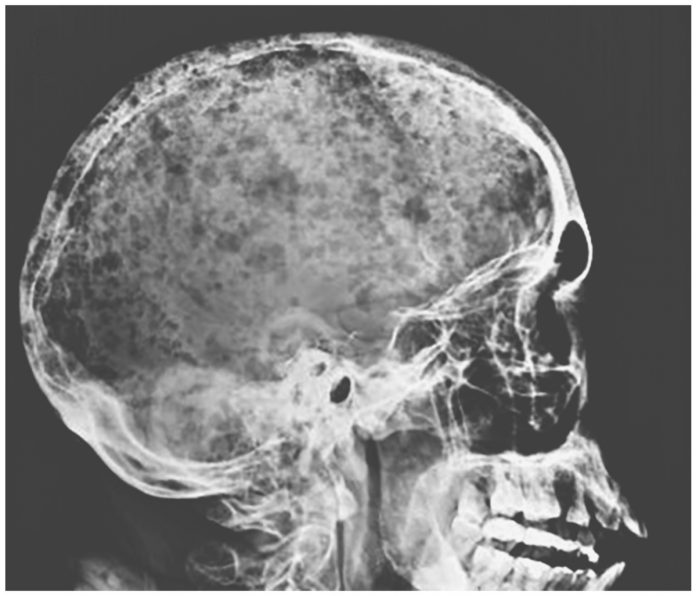A 46-year-old man diagnosed with malignancy after presenting with tiredness, shortness of breath, and back pain for one month.
A 46-year-old man came to the emergency department with complaints of fatigue, breathlessness, and pain in the lower back for the past 1 month. The patient had lost 30-kgs over the past 10 months.
Physical Examination:
On examination, the patient appeared pale with pale conjunctiva and palms.
Laboratory investigations:
Serological results revealed the following results:
- Hemoglobin level – 4.9 g/deciliter (reference range, 12 to 16),
- Creatinine level – 5.4 mg/deciliter (480 μmol/liter; reference range, 0.4 to 1.0 mg/deciliter [35 to 88 μmol/liter]),
- Calcium level – 12 mg per deciliter (3 mmol/liter; reference range, 8.9 to 10.3 mg/deciliter [2.2 to 2.6 mmol/liter]).
A skeletal survey showed:
- Diffuse osteopenia
- Fracture of the pubic bone
- Multiple radiolucent skull lesions
The radiolucent, lytic, and punched-out lesion on the skull gave an appearance of a “raindrop skull,” resembling the pattern of raindrops hitting a surface and splashing.
The laboratory findings and the characteristic findings of the skeletal survey supported the diagnosis of multiple myeloma. Multiple myeloma, which is the second most common type of blood cancer after leukemia, is a cancer of the plasma cells, which in other words means unregulated overgrowth and overproduction of the plasma cells.
A bone marrow biopsy was performed to confirm the diagnosis. The results of the biopsy and aspirate showed 50% clonal plasma cells in the marrow. Plasma cells are an integral part of the immune system. They are a type of white blood cells that produce antibodies, called immunoglobulins, to fight against pathogens.
Serum protein electrophoresis revealed monoclonal IgA paraproteins.
To correct the anemia, the patient was initially managed with red cell transfusion, and to correct the hypercalcemia, the patient was started on hydration.
Induction therapy showed no positive results. Despite treatment, the patient, unfortunately, died after 3 months of diagnosis.
Clinical features of multiple myeloma
Usually, the patients present with anemia and its signs and symptoms, including fatiguability, pallor and shortness of breath, repeated infections, and hypercalcemia, including constipation, dehydration, bone pain, etc. Some patients may also present with clinical features of impaired kidney functions.
Standard treatment for multiple myeloma:
- Targeted therapy which includes treatment with targeted drugs such as Bortezomib (Velcade), carfilzomib (Kyprolis), and ixazomib (Ninlaro), either orally or intravenously.
- Biological therapy with biological drugs, including thalidomide (Thalomid), lenalidomide (Revlimid), and pomalidomide (Pomalyst).
- Chemotherapy.
- Intravenous or oral corticosteroids, such as prednisone and dexamethasone.
- Radiotherapy using X-rays and protons to damage the myeloma cells and retard their growth.
- Bone marrow transplant is the definitive treatment option for patients with multiple myeloma.
The overall prognosis of multiple myeloma is fair, with some statistics showing a median survival rate of 54%.
References
Fabio Solis, M. a. (2018, May 17). Raindrop Skull. Retrieved from The New England Journal of Medicine: https://www.nejm.org/doi/full/10.1056/NEJMicm1714471




